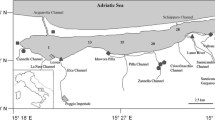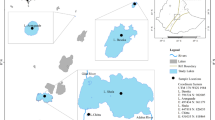Abstract
In the last 40 years, the shallow steppe lake, Neusiedler See, was ice covered between 0 and 97 days. The North Atlantic Oscillation (NAO) as well as the Mediterranean Oscillation affected the lake and its conditions during winter. Both climate indices correlated negatively with the duration of ice cover and the timing of ice-out. Average winter phytoplankton biomass increased from less than 0.2 (0.05–0.84) mg FM l−1 in the late 1960s/beginning of 1970s to 3.1 (1.72–5.61) mg FM l−1 in the years 2001–2004. The increase in annual winter biomass of phytoplankton was associated with a significant shift in the composition of the algal assemblage. In the winter 1997/1998, diatoms contributed between 40 and 80% to the phytoplankton biomass while in 2006/2007 cyanoprokaryotes contributed 46%. Mean chlorophyll-a concentrations during winter were significantly correlated with those of total phosphorus (Ptot). Together with cold-water species (rotifer Rhinoglena fertöensis), perennial, eurythermal ones (copepod Arctodiaptomus spinosus) contributed to the zooplankton community. High zooplankton numbers were encountered when rotifers, particularly when densities of Rhinoglena fertöensis were high (r 2 = 0.928). Zooplankton abundance and biomass varied from year to year but correlated positively with Chl-a (biomass − r 2 = 0.69; numbers − r 2 = 0.536). Winter zooplankton populations were primarily influenced by winter conditions, but in early winter also by survival of autumn populations, i.e., the more adults of Arctodiaptomus spinosus survived into winter, the higher was the zooplankton biomass in early winter. Phyto- and zooplankton dynamics in shallow lakes of the temperate region seem to critically depend on the biomass in autumn and on winter conditions, specifically on ice conditions and thus are related to climate signals such as the NAO.




Similar content being viewed by others
References
Adrian R, Deneke R, Mischke U, Stellmacher R, Lederer P (1995) A long-term study of the Heiligensee (1975–1992). Evidence for effects of climatic change on the dynamics of eutrophied lake ecosystems. Arch Hydrobiol 133:315–337
Adrian R, Walz N, Hintze T, Hoeg S, Rusche R (1999) Effects of ice duration on plankton succession during spring in a shallow polymictic lake. Freshwat Biol 41:621–623
Agbeti MD, Smol JP (1995) Winter limnology: a comparison of physical, chemical and biological characteristics in two temperate lakes during ice cover. Hydrobiologia 304:221–234
Andersen JM, Jacobsen OS (1979) Production and decomposition of organic matter in eutrophic Frederiksborg Slotssö, Denmark. Arch Hydrobiol 85:511–542
Andrew TE, Fitzsimons EM (1992) Seasonality, population dynamics and production of planktonic rotifers in Lough Neagh, Northern Ireland. Hydrobiologia 24:147–164
Assel RA, Herche LR (1998) Ice-on, ice-off, and ice duration for lakes and rivers with long-term records. In: Shen HT (ed) Ice in surface waters. Proc 14th international symposium on Ice, Potsdam, USA, Balkema, Rotterdam, pp 147–151
Barbanti L, Bonacina C, Calderoni A, Carollo A, de Bernardi R, Guilizzoni P, Nocentini AM, Ruggiu D, Saraceni C, Tonolli L (1974) Indagini ecologiche sul Lago d’Endine. Edizioni dell’Istituto Italiano di Idrobiologia Verbania, Pallanza
Bosselmann S (1974) The crustacean plankton of Lake Esrom. Arch Hydrobiol 74:18–31
Brandl Z (2005) Freshwater copepods and rotifers: predators and their pray. Hydrobiologia 546:475–489
Danilov RA, Ekelund GA (2001) Phytoplankton communities at different depths in two eutrophic and two oligotrophic temperate lakes at higher latitude during the period of ice cover. Acta Protozool 40:197–201
Dokulil M (1979) Optical properties, colour and turbidity. In: Löffler H (ed) Neusiedlersee: the limnology of a shallow lake in central Europe. Monographiae Biologicae, vol 37. Dr. W. Junk bv Publishers, The Hague, pp 151–167
Dokulil M (1984) Assessment of components controlling phytoplankton photosynthesis and bacterioplankton production in a shallow, alkaline, turbid lake (Neusiedlersee, Austria). Int Rev ges Hydrobiol 69:679–727
Dokulil M (2008) Comparative primary production. In: Likens GE (ed) Encyclopedia of inland waters. Elsevier, San Diego in print
Eckel O (1953) Zur Thermik des Neusiedlersees. Wetter Leben 5:72–78
Einsle U (1983) Die Limnologie des Mindelsees. In: Der Mindelsee bei Radolfzell. Monographie eines Naturschutzgebietes auf dem Bodanrück, Natur- und Landschaftsschutzgebiete Baden-Württemberg 11:161–218
Fitzsimons AG, Andrew TE (1993) The seasonal succession of the zooplankton of Lough Neagh. In: Wood RB, Smith RV (eds) Lough Neagh: the ecology of a multipurpose water resource, vol 69. Kluwer, Dordrecht, Boston London, pp 281–326 Monographiae Biologicae
Forsström L, Sorvari S, Rautio M, Sonninen E, Korhola A (2007) Changes in physical and chemical limnology and plankton during the spring melt period in a Subarctic Lake. Internat Rev Hydrobiol 30:1–325
George GE (2009) The impact of climate change on European lakes. Springer, Berlin in print
Gerten D, Adrian R (2000) Climate-driven changes in spring plankton dynamics and the sensitivity of shallow polymictic lakes to the North Atlantic oscillation. Limnol Oceanogr 45:1058–1066
Haberman J, Virro T (2004) Zooplankton. In: Haberman J, Pihu E, Raukas A (eds) Lake Võrtsjärv. Estonian Encyclopaedia Publishers, Tallin, pp 233–251
Herodek S, Oláh J (1973) Primary production in the frozen Lake Balaton. Annal Biol Tihany 40:197–201
Herodek S, Tamás G (1975) Phytoplankton production in Lake Balaton. Symp Biol Hung 15:29–34
Herzig A (1979) The zooplankton of the open lake. In: Löffler H (ed) Neusiedlersee. The limnology of a shallow lake in Central Europe, vol 37. Dr. W. Junk bv Publishers, The Hague, pp 281–335 Monographiae Biologicae
Herzig A (1980) Ten years quantitative data on a population of Rhinglena fertöensis (Brachionidae, Monogononta). Hydrobiologia 73:161–167
Herzig A (1983a) The ecological significance of the relationship between temperature and duration of embryonic development in planktonic freshwater copepods. Hydrobiologia 100:65–91
Herzig A (1983b) Comparative studies on the relationship between temperature and duration of embryonic development of rotifers. Hydrobiologia 104:237–246
Herzig A (1987) The analysis of planktonic rotifer populations: a plea for long-term investigations. Hydrobiologia 147:163–180
Herzig A (2001) Zooplankton. In: Dokulil M, Hamm A, Kohl J-G (eds) Ökologie und Schutz von Seen. Facultas UTB, Wien, pp 132–161
Herzig A, Dokulil M (2001) Neusiedler See—ein Steppensee in Europa. In: Dokulil M, Hamm A, Kohl J-G (eds) Ökologie und Schutz von Seen. Facultas UTB, Wien, pp 401–415
Hillebrand H, Dürselen CD, Kirschtel D, Pollingher U, Zohary T (1999) Biovolume calculation for pelagic and benthic microalgae. J Phycol 35:403–424
Jensen OP, Benson BJ, Magnuson JJ, Card VM, Futter MN, Sorrano PA, Stewart KM (2007) Spatial analysis of ice phenology trends across the Laurentian Great Lakes region during a recent warming period. Limnol Oceanogr 52:2013–2026
Jones HR, Lack TJ, Jones CS (1979) Population dynamics and production of Daphnia hyalina var. lacustris in Farmoor I, a shallow eutrophic reservoir. J Plankton Res 1:45–65
Karetnikov SG, Naumenko MA (2008) Recent trends in Lake Ladoga ice cover. Hydrobiologia 599:41–48
Kasprzak P, Ronneberger D (1982) Vergleichende Untersuchungen zur Struktur und Dynamik des Zooplanktons im Stechlinsee, Nehmitzsee und Haussee 1978/79. Limnologica (Berlin) 14:263–295
Leppäranta M (2009) Radiation transfer and heat budget during the ice season in Lake Pääjärvi. This volume
Leppäranta M, Reinart A, Erma A, Arst H, Hussainov M, Sipelgas L (2003) Investigation of ice and water properties and under-ice light fields in fresh and brackish water bodies. Nord Hydrol 34:245–266
Leßmann D, Ender R, Hofmann H, Rücker J, Beulker C, Nixdorf B (2003) Der Einfluß lang dauernder Eisbedeckung auf die Phytoplankton-Entwicklung in sauren Tagbauseen. Dt Ges Limnol (DGL) Tagungsbericht (Köln) Werder 2003
Livingstone DM (1999) Ice break-up on southern Lake Baikal and its relationship to local and regional air temperatures in Siberia and to the North Atlantic oscillation. Limnol Oceanogr 44:1486–1497
Livingstone DM (2000) Large-scale climatic forcing detected in historical observations of lake ice break-up. Verh Internat Verein Limnol 27:2775–2783
Livingstone DM, Adrian R, Arvola L, Blenckner T, Dokulil MT, Hari RE, George DG, Jankowski T, Järvinen M, Jennings E, Nöges P, Nöges T, Straile D, Weyhenmayer GA (2008) Regional and supra-regional coherence in limnological variables. In: George DG (ed) The impact of climate change on European Lakes. Springer, Berlin in print
Löffler H (1979) Neusiedlersee: the limnology of a shallow lake in central Europe. Monographiae Biologicae, vol 37. Dr. W. Junk Publisher, The Hague, pp 1–543
Lorenzen CJ (1967) Determination of chlorophyll and phaeopigments: spectrophotometric equations. Limnol Oceanogr 12:343–346
Morabito G, Ruggio D, Panzani P (2002) Recent dynamics (1995–1999) of the phytoplankton assemblages in Lago Maggiore as a basic tool for defining association patterns in the Italian deep lakes. J Limnol 61:129–145
Morscheid H (1999) Entwicklung und Stellung des Zooplanktons im pelagischen Ökosystem des Ammersees nach der Oligotrophierung (1993–1997). PhD thesis, Univ Vienna
Nauwerck A (1963) Die Beziehungen zwischen zooplankton und phytoplankton im See Erken. Uppsala, Schweden. Symp bot Upsal 17:1–163
Paloheimo JE (1974) Calculation of instantaneous birth rate. Limnol Oceanogr 19:692–694
Pechlaner R (1971) Factors that control the production rate and biomass of phytoplankton in high mountain lakes. Mitt Internat Verein Limnol 19:125–145
Phillips KA, Fawley MW (2002) Winter phytoplankton community structure in three shallow temperate lakes during ice cover. Hydrobiologia 470:97–113
Pohlmann M, Friedrich G (2001) Bestimmung der Phytoplanktonvolumina—Methodik und Ergebnisse am Beispiel Niederrhein. Limnologica 31:229–238
Ravera O (1969) Seasonal variation of the biomass and biocoenotic structure of plankton of the Bay of Ispra (Lago Maggiore). Verh Internat Verein Limnol 17:237–254
Reitner B, Herzig A, Herndl G (1997) Microbial activity under the ice cover of the shallow Neusiedler See (Austria, Central Europe). Hydrobiologia 357:173–184
Rodhe W (1955) Can plankton production proceed during winter darkness in subarctic lakes? Verh Internat Verein Limnol 12:117–122
Rott E (1981) Some results from phytoplankton counting intercalibrations. Schweiz Z Hydrol 43:35–62
Schiemer F (1979) The benthic communities of the open lake. In: Löffler H (ed) Neusiedlersee: the limnology of a shallow lake in central Europe. Monographiae Biologicae, vol 37. Dr. W. Junk bv Publishers, The Hague, pp 337–384
Schrimpf A (1994) Auswirkungen von Restaurierungsmaßnahmen auf zwei Kleinseen in Bayern und Tirol unter besonderer Berücksichtigung des Zooplanktons. PhD thesis Univ. Innsbruck
Šporka F, Livingstone DM, Stuchlík E, Turek J, Galas J (2006) Water temperatures and ice cover in lakes of the Tatra Mountains. Biologia. Bratislava 61(Suppl. 18):S77–S90
Sušelj K, Bergant K (2006) Mediterranean oscillation index. Geophys Res 8:02145 Abstracts
Talling JF (1962) Freshwater algae. In: Lewin RA (ed) Physiology and biochemistry of algae. Academic Press, New York, pp 743–757
Tryfiates GW (1960) Algal photosynthesis as measured by absorption of radioactive carbon from water. Ohio J Sci 60:77–82
Utermöhl H (1958) Zur Vervollkommnung der quantitativen Phytoplankton Methodik. Mitt Internat Verein Limnol 9:1–38
Vörös L, Mózes A, Somogyi B (2009) A five-year study of autotrophic winter picoplankton in Lake Balaton, Hungary. This volume
Walz N, Elster HJ, Mezger M (1987) The development of the rotifer community structure in Lake Constance during its eutrophication. Arch Hydrobiol 74:452–487 Monogr Beiträge
Weyhenmeyer GA, Meili M, Livingstone DM (2004) Nonlinear temperature response of lake ice breakup. Geophys Res Letters 31:L07203. doi:10.1029/2004GL019530
Wright RT (1964) Dynamics of a phytoplankton community in an ice covered lake. Limnol Oceanogr 9:163–178
Acknowledgments
The continuous support of the staff of the Biological Station Neusiedler See (especially R. Haider, R. Klein, F. Rauchwarter and R. Schalli) is gratefully acknowledged. We thank H. Krisa who did the phytoplankton counts and biomass calculations since 1995. The comments of the reviewers are acknowledged; they helped to improve the manuscript.
Author information
Authors and Affiliations
Corresponding author
Rights and permissions
About this article
Cite this article
Dokulil, M.T., Herzig, A. An analysis of long-term winter data on phytoplankton and zooplankton in Neusiedler See, a shallow temperate lake, Austria. Aquat Ecol 43, 715–725 (2009). https://doi.org/10.1007/s10452-009-9282-3
Received:
Accepted:
Published:
Issue Date:
DOI: https://doi.org/10.1007/s10452-009-9282-3




